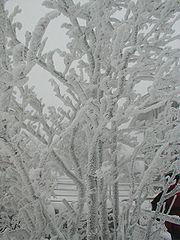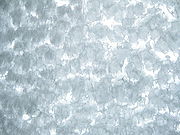
Rime (frost)
Encyclopedia



Ice
Ice is water frozen into the solid state. Usually ice is the phase known as ice Ih, which is the most abundant of the varying solid phases on the Earth's surface. It can appear transparent or opaque bluish-white color, depending on the presence of impurities or air inclusions...
that forms when the water
Water
Water is a chemical substance with the chemical formula H2O. A water molecule contains one oxygen and two hydrogen atoms connected by covalent bonds. Water is a liquid at ambient conditions, but it often co-exists on Earth with its solid state, ice, and gaseous state . Water also exists in a...
droplet
Drop (liquid)
A drop or droplet is a small column of liquid, bounded completely or almost completely by free surfaces. A drop may form when liquid accumulates at the lower end of a tube or other surface boundary, producing a hanging drop called a pendant drop...
s in fog
Fog
Fog is a collection of water droplets or ice crystals suspended in the air at or near the Earth's surface. While fog is a type of stratus cloud, the term "fog" is typically distinguished from the more generic term "cloud" in that fog is low-lying, and the moisture in the fog is often generated...
freeze
Freezing
Freezing or solidification is a phase change in which a liquid turns into a solid when its temperature is lowered below its freezing point. The reverse process is melting....
to the outer surfaces of objects. It is often seen on tree
Tree
A tree is a perennial woody plant. It is most often defined as a woody plant that has many secondary branches supported clear of the ground on a single main stem or trunk with clear apical dominance. A minimum height specification at maturity is cited by some authors, varying from 3 m to...
s atop mountain
Mountain
Image:Himalaya_annotated.jpg|thumb|right|The Himalayan mountain range with Mount Everestrect 58 14 160 49 Chomo Lonzorect 200 28 335 52 Makalurect 378 24 566 45 Mount Everestrect 188 581 920 656 Tibetan Plateaurect 250 406 340 427 Rong River...
s and ridge
Ridge
A ridge is a geological feature consisting of a chain of mountains or hills that form a continuous elevated crest for some distance. Ridges are usually termed hills or mountains as well, depending on size. There are several main types of ridges:...
s in winter, when low-hanging cloud
Cloud
A cloud is a visible mass of liquid droplets or frozen crystals made of water and/or various chemicals suspended in the atmosphere above the surface of a planetary body. They are also known as aerosols. Clouds in Earth's atmosphere are studied in the cloud physics branch of meteorology...
s cause freezing fog. This fog freezes to the windward (wind
Wind
Wind is the flow of gases on a large scale. On Earth, wind consists of the bulk movement of air. In outer space, solar wind is the movement of gases or charged particles from the sun through space, while planetary wind is the outgassing of light chemical elements from a planet's atmosphere into space...
-facing) side of tree branches, buildings, or any other solid objects, usually with high wind velocities and air temperatures between −2 °C (28 °F) and −8 °C (18 °F).
Hard rime formations are difficult to shake off; they have a comb-like appearance, unlike soft rime
Soft rime
Soft rime is a white ice deposition that forms when the water droplets in light freezing fog or mist freeze to the outer surfaces of objects, with calm or light wind...
, which looks feathery or spiky, or clear ice
Clear ice
Clear ice refers to a solid precipitation which forms when air temperature is between 0 °C and -3 °C and there are supercooled, relatively large drops of water...
, which looks homogeneous and transparent.
Scientists at meteorologically extreme places such as Mount Washington
Mount Washington (New Hampshire)
Mount Washington is the highest peak in the Northeastern United States at , famous for dangerously erratic weather. For 76 years, a weather observatory on the summit held the record for the highest wind gust directly measured at the Earth's surface, , on the afternoon of April 12, 1934...
in New Hampshire
New Hampshire
New Hampshire is a state in the New England region of the northeastern United States of America. The state was named after the southern English county of Hampshire. It is bordered by Massachusetts to the south, Vermont to the west, Maine and the Atlantic Ocean to the east, and the Canadian...
often have to break huge chunks of hard rime off weather equipment, in order to keep anemometer
Anemometer
An anemometer is a device for measuring wind speed, and is a common weather station instrument. The term is derived from the Greek word anemos, meaning wind, and is used to describe any airspeed measurement instrument used in meteorology or aerodynamics...
s and other measuring instruments operating.
Rime ice can accumulate on the leading edges and control surfaces of aircraft operating in certain meteorological conditions.
Meteorologists
Meteorology
Meteorology is the interdisciplinary scientific study of the atmosphere. Studies in the field stretch back millennia, though significant progress in meteorology did not occur until the 18th century. The 19th century saw breakthroughs occur after observing networks developed across several countries...
distinguish between three basic types of ice forming on vertical and horizontal surfaces by deposition of supercooled water droplets. Of course there are also intermediate formations.
- Soft rime is less dense than hard rime and is milky and crystalline, like sugar. Soft rime appears similar to hoar frost.
- Hard rime is somewhat less milky, especially if it is not heavy.
- Clear ice is transparent and homogeneous and resembles ice-cube ice in appearance. Its amorphous, dense structure helps it cling tenaciously to any surface on which it forms.
Both rime types are less dense than clear ice and cling less tenaciously, therefore damage due to rime is generally minor compared to clear ice.
Glaze ice
Glaze ice
Glaze ice or simply glaze is a smooth, transparent and homogenous ice coating occurring when freezing rain or drizzle hits a surface. It is similar in appearance to clear ice, which forms from supercooled water droplets...
is similar in appearance to clear ice but it is the result of a completely different process, occurring during freezing rain
Freezing rain
Freezing rain is the name given to rain that falls when surface temperatures are below freezing. The raindrops become supercooled while passing through a sub-freezing layer of air, many hundred feet , just above the surface, and then freeze upon impact with any object they encounter. The resulting...
or drizzle
Freezing drizzle
Freezing drizzle is drizzle that freezes on contact with the ground or an object at or near the surface. Its METAR code is FZDZ. When freezing drizzle accumulates on land it creates an icy layer of glaze...
.
These three types occur also when ice forms on the surface of an aircraft when it flies through a cloud made of supercooled water liquid droplets. Rime ice is the less dense, milky ice is intermediate and clear ice is the most dense. Dense ice can spoil lift and may have a catastrophic effect on an airborne aircraft.
Formation on snow crystals

Snow
Snow is a form of precipitation within the Earth's atmosphere in the form of crystalline water ice, consisting of a multitude of snowflakes that fall from clouds. Since snow is composed of small ice particles, it is a granular material. It has an open and therefore soft structure, unless packed by...
may encounter and pass through atmospheric supercooled cloud droplets. These droplets, which have a diameter of about 10 μm, can exist in the unfrozen state down to temperatures near -40 °C. Contact between the snow crystal and the supercooled droplets results in freezing of the liquid droplets onto the surface of the crystals. This process of crystal growth is known as accretion. Crystals that exhibit frozen droplets on their surfaces are referred to as rimed. When this process continues so that the shape of the original snow crystal is no longer identifiable, the resulting crystal is referred to as graupel
Graupel (snow)
Graupel refers to precipitation that forms when supercooled droplets of water are collected and freeze on a falling snowflake, forming a 2–5 mm ball of rime...
.
The frozen droplets on the surface of rimed crystals are hard to resolve and the topography of a graupel particle is not easy to record with a visible-wavelength microscope
Microscope
A microscope is an instrument used to see objects that are too small for the naked eye. The science of investigating small objects using such an instrument is called microscopy...
because of the limited resolution and depth of field in the instrument. However, observations of snow crystals with a low-temperature scanning electron microscope
Scanning electron microscope
A scanning electron microscope is a type of electron microscope that images a sample by scanning it with a high-energy beam of electrons in a raster scan pattern...
(LT-SEM) clearly show cloud droplets measuring up to 50 μm on the surface of the crystals. The rime has been observed on all four basic forms of snow crystals, including plates, dendrites, columns and needles. As the riming process continues, the mass of frozen, accumulated cloud droplets obscures the identity of the original snow crystal, thereby giving rise to a graupel particle.

